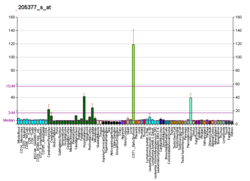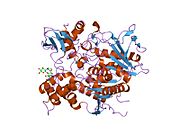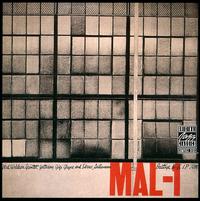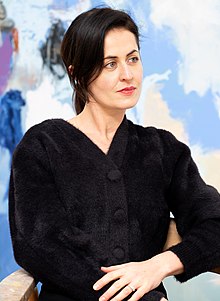아세틸콜린에스테라아제
Acetylcholinesterase| 아세틸콜린에스테라아제 | |||||||||
|---|---|---|---|---|---|---|---|---|---|
아세틸콜린에스테라아제는 아세틸콜린의 아세트산 이온 및 콜린으로의 가수분해를 촉매한다. | |||||||||
| 식별자 | |||||||||
| EC 번호 | 3.1.1.7 | ||||||||
| CAS 번호 | 9000-81-1 | ||||||||
| 데이터베이스 | |||||||||
| 인텐츠 | IntEnz 뷰 | ||||||||
| 브렌다 | 브렌다 엔트리 | ||||||||
| ExPASy | NiceZyme 뷰 | ||||||||
| 케그 | KEGG 엔트리 | ||||||||
| 메타사이크 | 대사 경로 | ||||||||
| 프라이머리 | 프로필 | ||||||||
| PDB 구조 | RCSB PDB PDBe PDBum | ||||||||
| 진 온톨로지 | AmiGO / QuickGO | ||||||||
| |||||||||
| 아프다 | |||||||||||||||||||||||||||||||
|---|---|---|---|---|---|---|---|---|---|---|---|---|---|---|---|---|---|---|---|---|---|---|---|---|---|---|---|---|---|---|---|
 | |||||||||||||||||||||||||||||||
| |||||||||||||||||||||||||||||||
| 식별자 | |||||||||||||||||||||||||||||||
| 에일리어스 | ACHE, ACHE, 아세틸히드로라아제, 아세틸콜린에스테라아제(YT 혈액형), ACE, ARN-YT, 아세틸콜린에스테라아제(카트라이트 혈액형), 진정한 콜린에스테라아제(일자 동의어) | ||||||||||||||||||||||||||||||
| 외부 ID | OMIM : 100740 MGI : 87876 HomoloGene : 543 GenCard : ACHE | ||||||||||||||||||||||||||||||
| |||||||||||||||||||||||||||||||
| |||||||||||||||||||||||||||||||
| |||||||||||||||||||||||||||||||
| |||||||||||||||||||||||||||||||
| 위키데이터 | |||||||||||||||||||||||||||||||
| |||||||||||||||||||||||||||||||
아세틸콜린에스테라아제(HGNC 기호 ACHE; EC 3.1.1.7; 계통명 아세틸콜린 아세틸히드로라아제)는 ACHE, AChase 또는 아세틸히드로라아제라고도 알려진 체내 1차 콜린에스테라아제이다.아세틸콜린과 신경전달물질로 기능하는 다른 콜린 에스테르 분해를 촉매하는 효소입니다.
- 아세틸콜린+HO2=콜린+아세테이트
그것은 주로 신경근 접합부 및 콜린 작동 유형의 화학적 시냅스에서 발견되며, 시냅스 전달을 종료하는 역할을 한다.그것은 카복실레스테라아제 계열의 효소들에 속합니다.신경제나 살충제와 같은 유기인 화합물에 의한 주요 억제 대상이다.
효소구조 및 메커니즘

ACHE는 콜린에스테르를 가수분해하는 가수분해효소이다.ACHE의 각 분자는 약 25,000개의 아세틸콜린(ACH) 분자를 초당 분해하여 [6][7]기질 확산에 의해 허용되는 한계에 도달합니다.ACHE의 활성 부위는 음이온 부위와 에스테라틱 부위의 2개의 부위로 구성된다.ACHE의 작용 구조와 메커니즘은 [8][9]효소의 결정 구조로부터 설명되었다.
음이온성 서브사이트는 아세틸콜린의 양성 제4급 아민과 다른 양이온성 기질 및 억제제를 수용한다.양이온 기질은 음이온 부위의 음전하 아미노산에 의해 결합되지 않고 활성 [10][11][12]부위로 이어지는 협곡에 늘어선 14개의 방향족 잔류물의 상호작용에 의해 결합됩니다.향기로운 협곡에 있는 14개의 아미노산은 모두 다른 [13]종에 걸쳐 보존성이 높습니다.방향족 아미노산 중 트립토판 84가 중요하며 알라닌과의 치환으로 반응성이 [14]3000배 감소한다.그 협곡은 효소의 중간을 관통하고 길이가 약 20앙스트롬이다.활성 부위는 분자 [15]바닥에서 4앙스트롬 위치에 있습니다.
아세틸콜린이 아세테이트 및 콜린으로 가수분해되는 에스테틱 부위는 세린 203, 히스티딘 447 및 글루탐산 334의 세 가지 아미노산의 촉매 삼합체를 포함한다.이 세 가지 아미노산은 글루타메이트가 아스파르트산이 아닌 세 번째 구성 요소라는 점을 제외하면 다른 세린 단백질 분해 효소의 삼합체와 유사합니다.또한 삼합체는 다른 단백질 [16]분해효소와는 반대 키라리티입니다.카르복실 에스테르의 가수분해 반응은 아실효소 및 유리콜린의 형성을 이끈다.그 후, 아실 효소는 히스티딘 440기의 도움을 받아 물 분자에 의한 친핵 공격을 받아 아세트산을 방출하고 유리 [17][18]효소를 재생한다.
생물학적 기능
신경전달 중에 ACh는 시냅스 전 뉴런에서 시냅스 구개로 방출되어 시냅스 후 막의 ACh 수용체에 결합되어 신경으로부터의 신호를 전달합니다.시냅스 후막에도 있는ACHE는 ACh를 가수분해하여 신호 전송을 종료합니다.해방된 콜린은 시냅스 전 뉴런에 의해 다시 흡수되고,[19][20] 콜린 아세틸전달효소 작용을 통해 아세틸-CoA와 결합하여 ACh를 합성한다.
콜린 자극제는 아세틸콜린에스테라아제의 용해 작용에 불침투하는 콜린 작동성 신경전달물질로 작용함으로써 이 과정을 방해한다.
질병 관련성
ACHE를 억제하는 약물이나 독소는 시냅스 내에서 고농도의 ACh를 지속시켜 중추신경계, 자율신경절 및 신경근 [21]접합부 내 콜린 작동성 신호를 증가시킨다.
ACHE의 불가역적 억제제는 근육 마비, 경련, 기관지 수축 및 질식에 의한 사망을 초래할 수 있다.유기인산(OP), 인산 에스테르(Esters)는 비가역성 ACHE 억제제의 [22]일종이다.ACHE에 의한 OP의 분해는 에스테라틱 사이트에 포스포릴기를 남긴다. 포스포릴기는 가수분해 속도가 느리고(일수씩), 공유 결합될 수 있다.돌이킬 수 없는 ACHE 억제제는 살충제(예: 말라티온)와 화학전을 위한 신경 가스(예: 사린과 소만)에 사용되어 왔다.N-메틸카르바민산의 에스테르인 카르바민산염은 ACHE 억제제로서 몇 시간 만에 가수분해되며 의료 목적으로 사용되어 왔다(예: 녹내장 치료를 위한 피소스티그민).가역적 억제제는 짧은 시간 동안(초에서 분) 동안 에스테라틱 부위를 차지하고 다양한 중추신경계 질환의 치료에 사용된다.테트라히드로아미노아크리딘(THA)과 도네페질(Donepezil)은 알츠하이머병의 인지 기능을 향상시키기 위해 FDA 승인을 받았다.또한 리바스티그민은 알츠하이머와 루이 신체 치매 치료에 사용되며, 피리도스티그민 브롬화물은 근육력증 치료에 [23][24][25][26][27][28]사용된다.
신경세포에서 ACHE의 내인성 억제제는 Mir-132 마이크로RNA로, 이것은 이 단백질의 발현을 침묵시키고 ACh가 항염증 [29]용량으로 작용하도록 함으로써 뇌의 염증을 제한할 수 있다.
또한 대마초의 주요 유효성분인 테트라히드로카나비놀은 아세틸콜린에스테라아제의 [30]경쟁적 억제제인 것으로 나타났다.
분배
ACHE는 신경과 근육, 중추와 말초 조직, 운동과 감각 섬유, 그리고 콜린 작동성 섬유와 비콜린 작동성 섬유 등 많은 종류의 전도성 조직에서 발견됩니다.ACHE의 활동은 감각 [31][32][33]뉴런보다 운동 뉴런에서 더 높다.
아세틸콜린에스테라아제는 적혈구 세포막에서도 발견되는데, 적혈구 세포막에서는 다양한 형태가 YT 혈액형 [34]항원을 구성합니다.아세틸콜린에스테라아제는 유사한 촉매 특성을 가진 여러 분자 형태로 존재하지만 올리고머 집합과 세포 표면에 대한 부착 양태가 다릅니다.
ACHE유전자
포유동물에서 아세틸콜린에스테라아제는 단일 ACHE 유전자에 의해 암호화되는 반면, 일부 무척추동물은 여러 개의 아세틸콜린에스테라아제 유전자를 가지고 있다.고등 척추동물은 또한 50% 아미노산 정체성을 가진 밀접하게 연관된 병렬 BCE(부틸콜린에스테라아제)를 [35]ACHE에 암호화한다.유일한 포유류 유전자로부터의 전사 산물의 다양성은 촉매 및 구조 서브유닛의 대체 mRNA 스플라이싱 및 번역 후 연관성에서 발생한다.T(꼬리), R(읽기), H(소수성)[36]의 세 가지 알려진 형태가 있습니다.
ACHET
뇌, 근육 및 기타 조직에서 발견되는 아세틸콜린에스테라아제의 주요 형태는 친수성 종으로 알려져 있으며, 친수성은 콜라겐성 또는 지질 함유 구조 서브유닛과 이황화물 결합 올리고머를 형성합니다.신경근접합에서 ACHE는 ColQ 또는 서브유닛과 관련된 비대칭 형태로 발현한다.중추신경계에서 그것은 대칭 형태를 형성하는 Proline Rich Membrane 닻을 나타내는 PRiMA와 연관되어 있다.어느 경우든 ColQ 또는 PRiMA 앵커는 세포간 접합에서 효소를 유지하고 신경근 접합에서는 ColQ, 시냅스에서는 PRiMA를 유지하는 역할을 한다.
ACHEH
다른 대체 접합 형태는 주로 적혈구 조직에서 발현되며, C 말단에서 다르며, PI 앵커 부위가 있는 절단성 소수성 펩타이드를 포함한다.번역 [37]후 첨가된 포스포이노시티드(PI) 부분을 통해 막과 결합됩니다.
ACHER
세 번째 유형은 지금까지 어뢰와 쥐에서만 발견되었지만 다른 종에서는 가설이 세워져 있다.스트레스 반응과 [38]염증에 관여하는 것으로 생각됩니다.
명명법
ACHE와 콜린에스테라아제의 명명학적 변화는 일반적으로 콜린에스테라아제 § 유형 및 명명법에서 논의된다.
억제제
아세틸콜린에스테라아제(ACHE)[39]의 경우, 가역적 억제제는 ACHE와 불가역적으로 결합되어 비활성화되지 않는 억제제이다.아세틸콜린에스테라아제를 가역적으로 억제하는 약물이 알츠하이머병이나 근육력증 등의 치료법으로 연구되고 있다.예를 들어 tacrine과 [40]donepezil이 있습니다.
아세틸콜린에스테라아제 억제제에 대한 노출은 걸프전에서 돌아온 후 퇴역 군인들에게 나타난 만성 인지 증상에 대한 여러 연구된 설명 중 하나이다.병사들은 ACH를 투여받았다.신경제 무기로부터 보호하는 EI 피리도스티그민 브롬화물(PB).미세투석과 HPLC-ECD를 사용하여 아세틸콜린 수치를 연구한 사우스캐롤라이나 의대 연구진은 스트레스 요소와 결합하면 PB가 인지 [41]반응으로 이어질 수 있다고 결정했다.
「 」를 참조해 주세요.
레퍼런스
- ^ a b c GRCh38: 앙상블 릴리즈 89: ENSG000087085 - 앙상블, 2017년 5월
- ^ a b c GRCm38: 앙상블 릴리즈 89: ENSMUSG000023328 - 앙상블, 2017년 5월
- ^ "Human PubMed Reference:". National Center for Biotechnology Information, U.S. National Library of Medicine.
- ^ "Mouse PubMed Reference:". National Center for Biotechnology Information, U.S. National Library of Medicine.
- ^ Katzung, BG (2001). "Introduction to Autonomic Pharmacology". Basic and Clinical Pharmacology (8th ed.). McGraw-Hill. pp. 75–91. ISBN 978-0-07-160405-5.
- ^ Quinn DM (1987). "Acetylcholinesterase: enzyme structure, reaction dynamics, and virtual transition states". Chemical Reviews. 87 (5): 955–79. doi:10.1021/cr00081a005.
- ^ Taylor P, Radić Z (1994). "The cholinesterases: from genes to proteins". Annual Review of Pharmacology and Toxicology. 34: 281–320. doi:10.1146/annurev.pa.34.040194.001433. PMID 8042853.
- ^ Sussman JL, Harel M, Frolow F, Oefner C, Goldman A, Toker L, Silman I (August 1991). "Atomic structure of acetylcholinesterase from Torpedo californica: a prototypic acetylcholine-binding protein". Science. 253 (5022): 872–9. Bibcode:1991Sci...253..872S. doi:10.1126/science.1678899. PMID 1678899. S2CID 28833513.
- ^ Sussman JL, Harel M, Silman I (June 1993). "Three-dimensional structure of acetylcholinesterase and of its complexes with anticholinesterase drugs". Chem. Biol. Interact. 87 (1–3): 187–97. doi:10.1016/0009-2797(93)90042-W. PMID 8343975.
- ^ Radić Z, Gibney G, Kawamoto S, MacPhee-Quigley K, Bongiorno C, Taylor P (October 1992). "Expression of recombinant acetylcholinesterase in a baculovirus system: kinetic properties of glutamate 199 mutants". Biochemistry. 31 (40): 9760–7. doi:10.1021/bi00155a032. PMID 1356436.
- ^ Ordentlich A, Barak D, Kronman C, Ariel N, Segall Y, Velan B, Shafferman A (February 1995). "Contribution of aromatic moieties of tyrosine 133 and of the anionic subsite tryptophan 86 to catalytic efficiency and allosteric modulation of acetylcholinesterase". J. Biol. Chem. 270 (5): 2082–91. doi:10.1074/jbc.270.5.2082. PMID 7836436.
- ^ Ariel N, Ordentlich A, Barak D, Bino T, Velan B, Shafferman A (October 1998). "The 'aromatic patch' of three proximal residues in the human acetylcholinesterase active centre allows for versatile interaction modes with inhibitors". Biochem. J. 335 (1): 95–102. doi:10.1042/bj3350095. PMC 1219756. PMID 9742217.

- ^ Ordentlich A, Barak D, Kronman C, Flashner Y, Leitner M, Segall Y, Ariel N, Cohen S, Velan B, Shafferman A (August 1993). "Dissection of the human acetylcholinesterase active center determinants of substrate specificity. Identification of residues constituting the anionic site, the hydrophobic site, and the acyl pocket". J. Biol. Chem. 268 (23): 17083–95. doi:10.1016/S0021-9258(19)85305-X. PMID 8349597.

- ^ Tougu V (2001). "Acetylcholinesterase: Mechanism of Catalysis and Inhibition". Current Medicinal Chemistry - Central Nervous System Agents. 1 (2): 155–170. doi:10.2174/1568015013358536.

- ^ Harel M, Schalk I, Ehret-Sabatier L, Bouet F, Goeldner M, Hirth C, Axelsen PH, Silman I, Sussman JL (1993). "Quaternary ligand binding to aromatic residues in the active-site gorge of acetylcholinesterase". Proceedings of the National Academy of Sciences of the United States of America. 90 (19): 9031–5. Bibcode:1993PNAS...90.9031H. doi:10.1073/pnas.90.19.9031. PMC 47495. PMID 8415649.
- ^ Tripathi A (October 2008). "Acetylcholinsterase: A Versatile Enzyme of Nervous System". Annals of Neurosciences. 15 (4): 106–111. doi:10.5214/ans.0972.7531.2008.150403.
- ^ Pauling L (1946). "Molecular Architecture and Biological Reactions" (PDF). Chemical & Engineering News. 24 (10): 1375–1377. doi:10.1021/cen-v024n010.p1375.
- ^ Fersht A (1985). Enzyme structure and mechanism. San Francisco: W.H. Freeman. p. 14. ISBN 0-7167-1614-3.
- ^ Whittaker VP (1990). "The Contribution of Drugs and Toxins to Understanding of Cholinergic Function" (PDF). Trends in Pharmacological Sciences. 11 (1): 8–13. doi:10.1016/0165-6147(90)90034-6. hdl:11858/00-001M-0000-0013-0E8C-5. PMID 2408211.
- ^ Purves D, Augustine GJ, Fitzpatrick D, Hall WC, LaMantia AS, McNamara JO, White LE (2008). Neuroscience (4th ed.). Sinauer Associates. pp. 121–2. ISBN 978-0-87893-697-7.
- ^ English, Brett A.; Webster, Andrew A. (2012). "Acetylcholinesterase and its Inhibitors". Primer on the Autonomic Nervous System. Elsevier. pp. 631–633. doi:10.1016/b978-0-12-386525-0.00132-3. ISBN 978-0-12-386525-0.
- ^ "National Pesticide Information Center-Diazinon Technical Fact Sheet" (PDF). Retrieved 24 February 2012.
- ^ "Clinical Application: Acetylcholine and Alzheimer's Disease". Retrieved 24 February 2012.
- ^ Stoelting RK (1999). Anticholinesterase Drugs and Cholinergic Agonists", in Pharmacology and Physiology in Anesthetic Practice. Lippincott-Raven. ISBN 978-0-7817-5469-9. Archived from the original on 2016-03-03. Retrieved 2012-02-26.
- ^ Taylor P, Hardman JG, Limbird LE, Molinoff PB, Ruddon RW, Gilman AG (1996). "5: Autonomic Pharmacology: Cholinergic Drugs". The Pharmacologial Basis of Therapeutics. THe McGraw-Hill Companies. pp. 161–174. ISBN 978-0-07-146804-6. Archived from the original on 2016-03-04. Retrieved 2012-02-26.
- ^ Blumenthal D, Brunton L, Goodman LS, Parker K, Gilman A, Lazo JS, Buxton I (1996). "5: Autonomic Pharmacology: Cholinergic Drugs". Goodman & Gilman's The pharmacological basis of therapeutics. New York: McGraw-Hill. p. 1634. ISBN 978-0-07-146804-6.
- ^ Drachman DB, Isselbacher KJ, Braunwald E, Wilson JD, Martin JB, Fauci AS, Kasper DL (1998). Harrison's Principles of Internal Medicine (14 ed.). The McCraw-Hill Companies. pp. 2469–2472. ISBN 978-0-07-020291-7.
- ^ Raffe RB (2004). Autonomic and Somatic Nervous Systems in Netter's Illustrated Pharmacology. Elsevier Health Science. p. 43. ISBN 978-1-929007-60-8.
- ^ Shaked I, Meerson A, Wolf Y, Avni R, Greenberg D, Gilboa-Geffen A, Soreq H (2009). "MicroRNA-132 potentiates cholinergic anti-inflammatory signaling by targeting acetylcholinesterase". Immunity. 31 (6): 965–73. doi:10.1016/j.immuni.2009.09.019. PMID 20005135.
- ^ Eubanks LM, Rogers CJ, Beuscher AE, Koob GF, Olson AJ, Dickerson TJ, Janda KD (2006). "A molecular link between the active component of marijuana and Alzheimer's disease pathology". Mol. Pharm. 3 (6): 773–7. doi:10.1021/mp060066m. PMC 2562334. PMID 17140265.
- ^ Massoulié J, Pezzementi L, Bon S, Krejci E, Vallette FM (July 1993). "Molecular and cellular biology of cholinesterases". Progress in Neurobiology. 41 (1): 31–91. doi:10.1016/0301-0082(93)90040-Y. PMID 8321908. S2CID 21601586.
- ^ Chacko LW, Cerf JA (1960). "Histochemical localization of cholinesterase in the amphibian spinal cord and alterations following ventral root section". Journal of Anatomy. 94 (Pt 1): 74–81. PMC 1244416. PMID 13808985.
- ^ Koelle GB (1954). "The histochemical localization of cholinesterases in the central nervous system of the rat". Journal of Comparative Anatomy. 100 (1): 211–35. doi:10.1002/cne.901000108. PMID 13130712. S2CID 23021010.
- ^ Bartels CF, Zelinski T, Lockridge O (May 1993). "Mutation at codon 322 in the human acetylcholinesterase (ACHE) gene accounts for YT blood group polymorphism". Am. J. Hum. Genet. 52 (5): 928–36. PMC 1682033. PMID 8488842.
- ^ Johnson G, Moore SW (2012). "Why has butyrylcholinesterase been retained? Structural and functional diversification in a duplicated gene. 2012". Neurochem. Int. 16 (5): 783–797. doi:10.1016/j.neuint.2012.06.016. PMID 22750491. S2CID 39348660.
- ^ Massoulié J, Perrier N, Noureddine H, Liang D, Bon S (2008). "Old and new questions about cholinesterases". Chem. Biol. Interact. 175 (1–3): 30–44. doi:10.1016/j.cbi.2008.04.039. PMID 18541228.
- ^ "Entrez Gene: ACHE acetylcholinesterase (Yt blood group)".
- ^ Dori A, Ifergane G, Saar-Levy T, Bersudsky M, Mor I, Soreq H, Wirguin I (2007). "Readthrough acetylcholinesterase in inflammation-associated neuropathies". Life Sci. 80 (24–25): 2369–74. doi:10.1016/j.lfs.2007.02.011. PMID 17379257.
- ^ Millard CB, Kryger G, Ordentlich A, Greenblatt HM, Harel M, Raves ML, Segall Y, Barak D, Shafferman A, Silman I, Sussman JL (June 1999). "Crystal structures of aged phosphonylated acetylcholinesterase: nerve agent reaction products at the atomic level". Biochemistry. 38 (22): 7032–9. doi:10.1021/bi982678l. PMID 10353814.
- ^ Julien RM, Advokat CD, Comaty JE (2007-10-12). A Primer of Drug Action (Eleventh ed.). Worth Publishers. pp. 50. ISBN 978-1-4292-0679-2.
- ^ Macht VA, Woodruff JL, Maissy ES, Grillo CA, Wilson MA, Fadel JR, Reagan LP (August 2019). "Pyridostigmine bromide and stress interact to impact immune function, cholinergic neurochemistry and behavior in a rat model of Gulf War Illness". Brain, Behavior, and Immunity. 80: 384–393. doi:10.1016/j.bbi.2019.04.015. PMC 6790976. PMID 30953774.
추가 정보
- Silman I, Futerman AH (1988). "Modes of attachment of acetylcholinesterase to the surface membrane". Eur. J. Biochem. 170 (1–2): 11–22. doi:10.1111/j.1432-1033.1987.tb13662.x. PMID 3319614.
- Sussman JL, Harel M, Frolow F, Oefner C, Goldman A, Toker L, Silman I (1991). "Atomic structure of acetylcholinesterase from Torpedo californica: a prototypic acetylcholine-binding protein". Science. 253 (5022): 872–9. Bibcode:1991Sci...253..872S. doi:10.1126/science.1678899. PMID 1678899. S2CID 28833513.
- Soreq H, Seidman S (2001). "Acetylcholinesterase--new roles for an old actor". Nature Reviews Neuroscience. 2 (4): 294–302. doi:10.1038/35067589. PMID 11283752. S2CID 5947744.
- Shen T, Tai K, Henchman RH, McCammon JA (2003). "Molecular dynamics of acetylcholinesterase". Acc. Chem. Res. 35 (6): 332–40. doi:10.1021/ar010025i. PMID 12069617.
- Pakaski M, Kasa P (2003). "Role of acetylcholinesterase inhibitors in the metabolism of amyloid precursor protein". Current Drug Targets. CNS and Neurological Disorders. 2 (3): 163–71. doi:10.2174/1568007033482869. PMID 12769797.
- Meshorer E, Soreq H (2006). "Virtues and woes of AChE alternative splicing in stress-related neuropathologies". Trends Neurosci. 29 (4): 216–24. doi:10.1016/j.tins.2006.02.005. PMID 16516310. S2CID 18983474.
- Ehrlich G, Viegas-Pequignot E, Ginzberg D, Sindel L, Soreq H, Zakut H (1992). "Mapping the human acetylcholinesterase gene to chromosome 7q22 by fluorescent in situ hybridization coupled with selective PCR amplification from a somatic hybrid cell panel and chromosome-sorted DNA libraries". Genomics. 13 (4): 1192–7. doi:10.1016/0888-7543(92)90037-S. PMID 1380483.
- Spring FA, Gardner B, Anstee DJ (1992). "Evidence that the antigens of the Yt blood group system are located on human erythrocyte acetylcholinesterase". Blood. 80 (8): 2136–41. doi:10.1182/blood.V80.8.2136.2136. PMID 1391965.
- Shafferman A, Kronman C, Flashner Y, Leitner M, Grosfeld H, Ordentlich A, Gozes Y, Cohen S, Ariel N, Barak D (1992). "Mutagenesis of human acetylcholinesterase. Identification of residues involved in catalytic activity and in polypeptide folding". J. Biol. Chem. 267 (25): 17640–8. doi:10.1016/S0021-9258(19)37091-7. PMID 1517212.
- Getman DK, Eubanks JH, Camp S, Evans GA, Taylor P (1992). "The human gene encoding acetylcholinesterase is located on the long arm of chromosome 7". Am. J. Hum. Genet. 51 (1): 170–7. PMC 1682883. PMID 1609795.
- Li Y, Camp S, Rachinsky TL, Getman D, Taylor P (1992). "Gene structure of mammalian acetylcholinesterase. Alternative exons dictate tissue-specific expression". J. Biol. Chem. 266 (34): 23083–90. doi:10.1016/S0021-9258(18)54466-5. PMID 1744105.
- Velan B, Grosfeld H, Kronman C, Leitner M, Gozes Y, Lazar A, Flashner Y, Marcus D, Cohen S, Shafferman A (1992). "The effect of elimination of intersubunit disulfide bonds on the activity, assembly, and secretion of recombinant human acetylcholinesterase. Expression of acetylcholinesterase Cys-580----Ala mutant". J. Biol. Chem. 266 (35): 23977–84. doi:10.1016/S0021-9258(18)54380-5. PMID 1748670.
- Soreq H, Ben-Aziz R, Prody CA, Seidman S, Gnatt A, Neville L, Lieman-Hurwitz J, Lev-Lehman E, Ginzberg D, Lipidot-Lifson Y (1991). "Molecular cloning and construction of the coding region for human acetylcholinesterase reveals a G + C-rich attenuating structure". Proceedings of the National Academy of Sciences of the United States of America. 87 (24): 9688–92. Bibcode:1990PNAS...87.9688S. doi:10.1073/pnas.87.24.9688. PMC 55238. PMID 2263619.
- Chhajlani V, Derr D, Earles B, Schmell E, August T (1989). "Purification and partial amino acid sequence analysis of human erythrocyte acetylcholinesterase". FEBS Lett. 247 (2): 279–82. doi:10.1016/0014-5793(89)81352-3. PMID 2714437. S2CID 41843002.
- Lapidot-Lifson Y, Prody CA, Ginzberg D, Meytes D, Zakut H, Soreq H (1989). "Coamplification of human acetylcholinesterase and butyrylcholinesterase genes in blood cells: correlation with various leukemias and abnormal megakaryocytopoiesis". Proceedings of the National Academy of Sciences of the United States of America. 86 (12): 4715–9. Bibcode:1989PNAS...86.4715L. doi:10.1073/pnas.86.12.4715. PMC 287342. PMID 2734315.
- Bazelyansky M, Robey E, Kirsch JF (1986). "Fractional diffusion-limited component of reactions catalyzed by acetylcholinesterase". Biochemistry. 25 (1): 125–30. doi:10.1021/bi00349a019. PMID 3954986.
- Gaston SM, Marchase RB, Jakoi ER (1982). "Brain ligatin: a membrane lectin that binds acetylcholinesterase". J. Cell. Biochem. 18 (4): 447–59. doi:10.1002/jcb.1982.240180406. PMID 7085778. S2CID 22975039.
- Ordentlich A, Barak D, Kronman C, Ariel N, Segall Y, Velan B, Shafferman A (1995). "Contribution of aromatic moieties of tyrosine 133 and of the anionic subsite tryptophan 86 to catalytic efficiency and allosteric modulation of acetylcholinesterase". J. Biol. Chem. 270 (5): 2082–91. doi:10.1074/jbc.270.5.2082. PMID 7836436.
- Maruyama K, Sugano S (1994). "Oligo-capping: a simple method to replace the cap structure of eukaryotic mRNAs with oligoribonucleotides". Gene. 138 (1–2): 171–4. doi:10.1016/0378-1119(94)90802-8. PMID 8125298.
- Ben Aziz-Aloya R, Sternfeld M, Soreq H (1994). "Promoter elements and alternative splicing in the human ACHE gene". Prog. Brain Res. 98: 147–53. doi:10.1016/s0079-6123(08)62392-4. PMID 8248502.
- Massoulié J, Pezzementi L, Bon S, Krejci E, Vallette FM (1993). "Molecular and Cellular Biology of Cholinesterases". Prog. Brain Res. 41 (1): 31–91. doi:10.1016/0301-0082(93)90040-Y. PMID 8321908. S2CID 21601586.
외부 링크
- 환경 의학 분야 ATSDR 도입 사례: 살충제와 화학전 신경제를 포함한 콜린에스테라아제 억제제 미국 보건복지부
- 프로테피디아 아세틸콜린에스테라아제
- 프로테피디아 ACHE_inhibiters_and_substrates
- 프로테피디아 ACHE_inhibiters_and_substrates_(부품)II)
- 프로테피디아 ACHE 2가 억제제 ACHE_biga_inhibters ACHE 2가 억제제
- 아세틸콜린에스테라아제: 협곡우스의 효소-PDBe
- 아세틸콜린에스테라아제-RCSB PDB
- UCSC Genome Browser의 Human ACH 게놈 위치 및 ACHE 유전자 세부 정보 페이지.
- PDBe-KB에서 UniProt: P22303(인간 아세틸콜린에스테라아제)에 대해 PDB에서 사용할 수 있는 모든 구조 정보의 개요.












